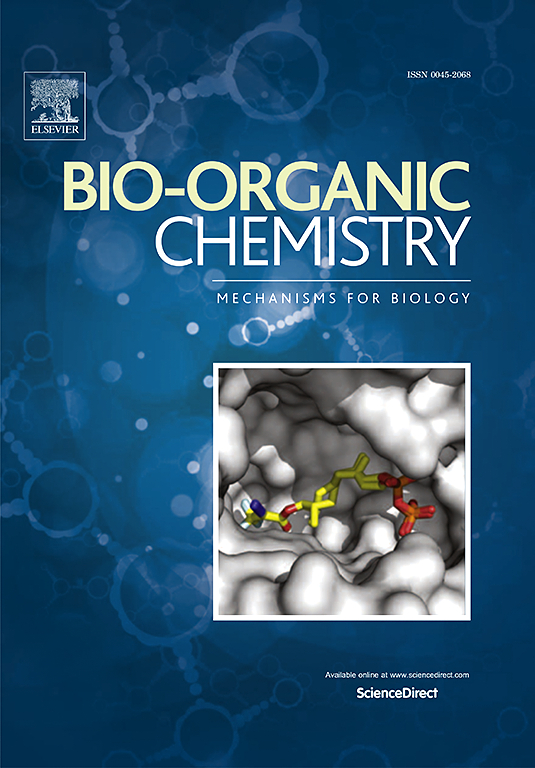Deciphering the landscape of allosteric glutaminase 1 inhibitors as anticancer agents
IF 4.5
2区 医学
Q1 BIOCHEMISTRY & MOLECULAR BIOLOGY
引用次数: 0
Abstract
Glutamine is the second most utilised energy source after glucose for cancer cells to support their proliferation and survival. Glutaminase 1 (GLS1) is the rate-limiting enzyme during the glutaminolysis pathway and thus represents a promising therapeutic target for the development of innovative antitumor agents. Two main classes of GLS1 inhibitors, based on their different binding mode, are reported: the substrate active site and the allosteric site inhibitors. Despite the intense efforts made to date, only two GLS1 inhibitors (i.e., CB-839 and IPN60090) have entered clinical trials. Therefore, this research field remains to be explored to improve the effectiveness of anticancer therapy. Hence, we describe the discovery and development of reversible allosteric GLS1 inhibitors disclosed in the last six years, dividing them based on their structural similarity with bis-2-(5-phenylacetamido-1,2,4-thiadiazol-2-yl)ethyl sulfide (BPTES) and CB-839. Furthermore, macrocyclic and thiadiazole derivatives, and other structurally different compounds are discussed to present a wider picture of the chemical space under investigation. The study of the binding interactions governing GLS1 inhibition is also analyzed, to help prospectively refine the structural features for greater efficacy. Interestingly, an overview of a new class of irreversible allosteric inhibitors targeting GLS1 Lys320 key residue is provided for the first time. We also summarize the most important biological studies conducted on CB-839 and IPN60090 and their significance for further assessment. The insights garnered from this paper are expected to guide future drug design endeavours toward the identification of novel therapeutics targeting GLS1 to complement and potentially enhance the arsenal of anticancer medications.

解读变构谷氨酰胺酶1抑制剂作为抗癌剂的前景
谷氨酰胺是癌细胞仅次于葡萄糖的第二大能量来源,用于支持癌细胞的增殖和生存。谷氨酰胺酶1 (GLS1)是谷氨酰胺水解途径中的限速酶,因此代表了开发创新抗肿瘤药物的有希望的治疗靶点。GLS1抑制剂根据其结合方式的不同,主要分为两类:底物活性位点抑制剂和变构位点抑制剂。尽管迄今为止付出了巨大的努力,但只有两种GLS1抑制剂(即CB-839和IPN60090)进入了临床试验。因此,为了提高抗癌治疗的有效性,这一研究领域仍有待探索。因此,我们描述了在过去六年中发现的可逆变构GLS1抑制剂的发现和发展,并根据它们与双-2-(5-苯基乙酰氨基-1,2,4-噻二唑-2-基)乙硫醚(BPTES)和CB-839的结构相似性对它们进行了分类。此外,还讨论了大环和噻二唑衍生物以及其他结构不同的化合物,以提供更广泛的化学研究空间。还分析了控制GLS1抑制的结合相互作用的研究,以帮助前瞻性地完善结构特征以获得更大的功效。有趣的是,本文首次综述了一类新的靶向GLS1 Lys320关键残基的不可逆变构抑制剂。我们还总结了CB-839和IPN60090最重要的生物学研究及其对进一步评价的意义。从本文中获得的见解有望指导未来的药物设计工作,以确定针对GLS1的新疗法,以补充并潜在地增强抗癌药物的武器库。
本文章由计算机程序翻译,如有差异,请以英文原文为准。
求助全文
约1分钟内获得全文
求助全文
来源期刊

Bioorganic Chemistry
生物-生化与分子生物学
CiteScore
9.70
自引率
3.90%
发文量
679
审稿时长
31 days
期刊介绍:
Bioorganic Chemistry publishes research that addresses biological questions at the molecular level, using organic chemistry and principles of physical organic chemistry. The scope of the journal covers a range of topics at the organic chemistry-biology interface, including: enzyme catalysis, biotransformation and enzyme inhibition; nucleic acids chemistry; medicinal chemistry; natural product chemistry, natural product synthesis and natural product biosynthesis; antimicrobial agents; lipid and peptide chemistry; biophysical chemistry; biological probes; bio-orthogonal chemistry and biomimetic chemistry.
For manuscripts dealing with synthetic bioactive compounds, the Journal requires that the molecular target of the compounds described must be known, and must be demonstrated experimentally in the manuscript. For studies involving natural products, if the molecular target is unknown, some data beyond simple cell-based toxicity studies to provide insight into the mechanism of action is required. Studies supported by molecular docking are welcome, but must be supported by experimental data. The Journal does not consider manuscripts that are purely theoretical or computational in nature.
The Journal publishes regular articles, short communications and reviews. Reviews are normally invited by Editors or Editorial Board members. Authors of unsolicited reviews should first contact an Editor or Editorial Board member to determine whether the proposed article is within the scope of the Journal.
 求助内容:
求助内容: 应助结果提醒方式:
应助结果提醒方式:


